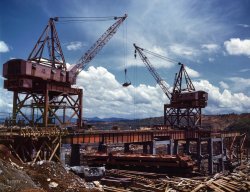
MAY CONTAIN NUTS

Search Shorpy
SHORPY ART

Framed or unframed, desk size to sofa size, printed by us in Arizona and Alabama since 2007. Explore now.
Join and Share
Ad-Free Shorpy
Shorpy is funded by you. Patreon contributors get an ad-free experience.
Learn more.

Recent comments
- Alas, hidden from view
- Exclusive pump
- Details, Details
- What's that building to the left of the tower?
- Coal Barges
- Bromo-Seltzer
- Inner harbor
- The Basin
- What a headache!
- Giant stepladder?
- Baldwin 62303
- Baldwin VO-1000
- Cold
- No expense spared
- Tough Guys
- Lost in Toyland
- And without gloves
- If I were a blindfolded time traveler
- Smoke Consumer Also Cooks
- Oh that stove!
- Possibly still there?
- What?!?
- $100 Reward
- Freeze Frame
- Texas Flyer wanted
- Just a Year Too Soon
- WWII -- Replacing men with women at the railroad crossing.
- Yes, Icing
- You kids drive me nuts!
- NOT An Easy Job
Member Photos
The Shorpy
Print Emporium
Print Emporium
Search Shorpy
Search results -- 30 results per page
- Angel Wing: 1943
- ... View full size. 4x5 Kodachrome transparency by Alfred Palmer for the Office of War Information.
These beautiful Kodachrome ... our troops abroad.
(The Gallery, Kodachromes, Alfred Palmer, Aviation, Nashville, WW2) ... Posted by Dave - 08/30/2012 - 2:02pm -
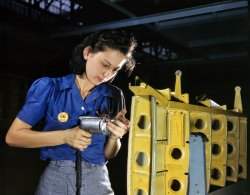
- Redacted: 1942
- ... have been scratched off the negative. Photo by Alfred Palmer for the Office of War Information. View full size.
Northern ... and flew members of the 508 PIR.
(The Gallery, Alfred Palmer, Aviation, Factories, WW2) ... Posted by Dave - 11/05/2021 - 4:01pm -
![Redacted: 1942 October 1942. "A long line of C-47 transport planes awaits the installation of wings at the Long Beach, California, plant of Douglas Aircraft Company. The versatile C-47 performs many important tasks for the Army. It ferries men and cargo across oceans and mountains, tows gliders and brings paratroopers and their equipment to scenes of action." Note how, as on the photo in the previous post, certain markings on the fuselage have been scratched off the negative. Photo by Alfred Palmer for the Office of War Information. View full size.
Northern HemisphereThey work clockwise around the room, going by tail numbers.
Remarkable numbersIn another part of the plant they produced B-17s under license from Boeing.
Between the two types they produced about one aircraft per hour during the War.
Namesake of the clothespinOn film sets and in photo studios it is cool to call clothespins C-47s, for their versatility.
Re: WingsIt's always amazed (or baffled) me, how the wings, carrying maybe 80% of the plane's weight, can attach to those root sections with bolts and/or rivets, and not just rip off!
Tail numbersThe tail number is a partial serial number. Tail number 118625 is serial number 41-18625, the 41 being the fiscal year the contract was let. With the help of the interweb place it is possible to trace each of these aircraft. Example: 118627 (41-18627) was transferred to the USAAF on Oct 26, 1942, then to Cairo on Feb 17, 1943, and then to the 8th Air Force in England on Feb 27, 1944. It was lost (missing) on Oct 24, 1944. www.joebaugher.com is the go-to source for aircraft history and information.
Censored ShipsI love the how the original negative had information on the nose of the aircraft redacted for OPSEC purposes. Fantastic image!
[Censor missed the placard at the back of the plane, which seems to be the same as the one at the front. - Dave]
Gooney Bird StatusAccording to an archive of serial numbers, 18629 survived and is awaiting restoration.
D-Day Ship#8632 was a D-Day ship and flew members of the 508 PIR.
(The Gallery, Alfred Palmer, Aviation, Factories, WW2)](https://www.shorpy.com/files/images/SHORPY-8b05585u.thumbnail.jpg)
- Fort Knox: 1942
- ... View full size. 4x5 Kodachrome transparency by Alfred Palmer, Office of War Information.
A triumph for democracy, and for ... so the shutter speed may have been 1/250 or even faster. Palmer got pretty good depth of field too -- several feet at least. That ... Posted by Dave - 08/03/2012 - 10:31pm -
![Fort Knox: 1942 June 1942. M-3 tank in action at Fort Knox, Kentucky. View full size. 4x5 Kodachrome transparency by Alfred Palmer, Office of War Information.
A triumph for democracy, and for KodachromeTeam Shorpy - Any chance of our seeing what this image looked like before color correction?
This is a great shot, and I am intrigued by the conditions under which it was taken. I do not think color films in 1942 were very quick; this was probably shot on what would today be called iso 25 or iso 50 film. However, the dust clouds and tank treads are frozen, so the shutter speed may have been 1/250 or even faster. Palmer got pretty good depth of field too -- several feet at least. That combination suggests that this photo was taken in very bright sunlight.
Traditionally, such a dark blue sky suggests that a polarizing filter was used, but that would have cut down on light and Palmer needed all the light he could get for this shot. Was it enhanced in Photoshop?
I wonder if this tank would have seemed impressive or threatening to viewers of this photograph in 1942. To my eye, it looks cute, but perhaps that's the result of decades of exposure to much larger and more dangerous machines.
[Original image below. - Dave]
Central Harlem's Uniformed QuestionIn 1942 Kodachrome had a film speed of Weston 8 which corresponded EXACTLY to ASA 10, which corresponds exactly to ISO 10. There is no reason to believe that Kodachrome would have suffered any color deterioration WHATEVER since this image was processed and stored in 1942, so the colors you see here are probably exceedingly close to what you they were in 1942, allowing for the vagaries of present-day scanning, conversion to digital electronic format, and display. The colors as presented here are typical of what can be seen from properly stored Kodachrome transparencies from the 1940s, perhaps originally exposed through a polarizer, though not necessarily. Consult the Wikipedia article on Kodachrome for more on all this.
[So, what kind of uniform does a "uniformed" question wear? Dress blues? Irritating, obtuse comment of the day. But the day is young! - Dave]
The TankAs far as Central Harlem Anonymous's question as to whether "this tank would have seemed impressive or threatening to viewers of this photograph in 1942," the answer is that to the uninformed viewer it would have seemed quite impressive, but to anyone who had much knowledge about armor it would not be well regarded at all. The M-3 - known to the British as the General Lee - was pretty much obsolescent when it came off the production line. The 75 mm main gun is impressive enough but it is mounted in a sponson on the right side of the tank's hull giving it a limited field of fire of about 15 degrees to the right or left of center. The secondary gun, a 37 mm turret mounted gun (in this tank either removed, not mounted or cut off) was a fairly decent gun but didn't have the striking power of the guns that even the German Panzer IV had. And that was weak compared to what the Tiger Tanks that the Germans were producing had. The turret itself is a disaster - far too high and a very inviting target. The British bought a large number of the M-3s to cover their own shortfalls in tank production and the first thing they did was to replace the turret with a lower one of their own design. The result was the "General Grant" which was one of the main tanks of Montgomery's Eighth Army at the Battle of El Alamein. The Grants and Lees were taken out of service by the time of the invasion of Sicily, though some were used by the British in the Burma theater of operations where the Japanese tanks were truly pathetic. The Russians were given some through Lend-Lease; they referred to the Lee as "a coffin for seven brothers." Of course by this time the Russians were operating the beautiful T-34. The US Army would eventually use the body of the M-3, heavily modified, to create a self propelled gun type, the M-7 Priest.
(The Gallery, Kodachromes, Alfred Palmer, WW2)](https://www.shorpy.com/files/images/1a35204u1.thumbnail.jpg)
- The Red Socks: 1942
- ... View full size. 4x5 Kodachrome transparency by Alfred Palmer for the Office of War Information.
Numbers That woman is ... are employee number.
(The Gallery, Kodachromes, Alfred Palmer, Aviation, WW2) ... Posted by Dave - 08/03/2012 - 10:44pm -
![The Red Socks: 1942 October 1942. Yet another still from the Technicolor pajama party that was the American aircraft industry in World War II: "Women at work on bomber, Douglas Aircraft Company, Long Beach, California." View full size. 4x5 Kodachrome transparency by Alfred Palmer for the Office of War Information.
NumbersThat woman is gorgeous! Anyone have any idea what the numbers on their pins signify?
[Employee ID tags. - Dave]
BaggiesIt appears that incredibly wide-legged jeans have been here before! Iimagine that the numbers were some kind of employee ID?
Douglas AircraftNo. 12 is the department; the others are employee number.
(The Gallery, Kodachromes, Alfred Palmer, Aviation, WW2)](https://www.shorpy.com/files/images/1a35341u.thumbnail.jpg)
- Test Pilot: 1942
- ... View full size. 4x5 Kodachrome transparency by Alfred Palmer.
Looks I can't believe that no one has commented on this man's ... aeronautic outfits.
(The Gallery, Kodachromes, Alfred Palmer, Aviation, WW2) ... Posted by Dave - 07/17/2012 - 10:10pm -
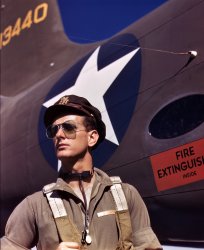
- Big Steel: 1941
- ... View full size. 4x5 Kodachrome transparency by Alfred Palmer.
My Hometown These were gone by the time I was born in 1961. My ... to hang on my wall!
(The Gallery, Kodachromes, Alfred Palmer, Factories, Farked) ... Posted by Dave - 08/03/2012 - 10:34pm -

- Mobilized: 1942
- ... to scenes of action." 4x5 inch acetate negative by Alfred Palmer for the Office of War Information. View full size.
Lunch Boxes ... back in the day. - Dave]
(The Gallery, Alfred Palmer, Aviation, Factories, WW2) ... Posted by Dave - 11/04/2021 - 3:30pm -
![Mobilized: 1942 October 1942. "Great numbers of C-47 transport planes move along the assembly lines at the Douglas Aircraft Company plant at Long Beach, California. The versatile C-47 performs many important tasks for the Army. It ferries men and cargo across oceans and mountains, tows gliders and brings paratroopers and their equipment to scenes of action." 4x5 inch acetate negative by Alfred Palmer for the Office of War Information. View full size.
Lunch BoxesI carried one of those for almost 35 years. When I retired, my wife gave it away without telling me. Horror! I still loved her.
Big BizWars are certainly good for industry. The sheer volume of aircraft, tanks, guns, ships, freight trains, trucks, armored vehicles, submarines, ammunition, bombs, etc, and all its infrastructure, produced in short order from all sides was staggering.
Smoke 'em if you got 'emPretty sure that's a cigarette machine under the left wingtip.
The Gooney BirdArguably (but not for me) the greatest aircraft ever built.
This Could Be One of Those PlanesWith what I believe is a C-47 behind them, this is my father when he was on a war bond tour in September 1943. He had served early in the war as a tank commander in North Africa and was injured. Because of his war record he was selected to accompany several movie stars of the time to help sell war bonds. My father is the army man kneeling in front. The lady directly behind him is an actress named Helen Walker. Next to her is Albert Dekker, of Dr. Cyclops fame. The lady to the right of him is actress Elyse Knox. She would later be married to Tom Harmon and is the mother of Mark Harmon.
Plate or door?What is that square plate or door above the pilot's station on the top of the fuselage? Some kind of door? A plate covering some kind of electronic equipment?
The round one that's inboard and aft a bit is for the Navigator's acrylic dome I believe.
Clean plant!Can you imagine in today's world trying to mobilize like America did in WWII?
Railroads trying to handle the traffic? For that matter, just the people bonding together.
Unbelievable output by our factories, many repurposed to produce war materiel.
Amazing.
The Old DaysWhen you could find a cigarette machine in your workplace conveniently near where your locker and lunch are located.
Gooney BirdsWas the affectionate term for the venerable C-47. A quarter century after this photo the Air Force gave me my first (uncomfortable) airplane trip in one of them.
The plate above the flight deck is an escape hatch. What is known as an "astrodome" was, indeed, a plexiglass dome for the navigator to take celestial bearings.
Food safety?I would hope all those lunch boxes we're seeing on top of the lockers are there post-lunch instead of pre-lunch. Maybe refrigeration wasn't that big of a concern back then.
[What planet did you grow up on? You are evidently not one of the eighty zillion schoolkids who ate from unrefrigerated lunchboxes back in the day. - Dave]
(The Gallery, Alfred Palmer, Aviation, Factories, WW2)](https://www.shorpy.com/files/images/SHORPY-8b05587u.thumbnail.jpg)
- B-25 Final Assembly
- ... Inglewood, Calif." Kodachrome transparency by Alfred Palmer. View full size.
Tokyo Bombed April 18, 1942 by B25's ... after Pearl Harbor!
(The Gallery, Kodachromes, Alfred Palmer, Aviation, Factories, WW2) ... Posted by Dave - 08/03/2012 - 11:01pm -
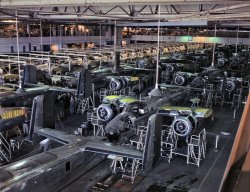
- Clerk 37: 1942
- ... View full size. 4x5 Kodachrome transparency by Alfred Palmer.
4 x 5 Kodachrome These pictures are wonderful - however, I ... 808, in Section 37.
(The Gallery, Kodachromes, Alfred Palmer, Aviation, WW2) ... Posted by Dave - 08/03/2012 - 3:24pm -
![Clerk 37: 1942 October 1942. "Clerk in North American Aviation stockroom, checking to see if the proper numbers of parts were received and placed in the proper bin. Inglewood, California. This plant produces the battle-tested B-25 (Billy Mitchell) bomber, used in General Doolittle's raid on Tokyo, and the P-51 (Mustang) fighter plane which was first brought into prominence by the British raid on Dieppe." View full size. 4x5 Kodachrome transparency by Alfred Palmer.
4 x 5 KodachromeThese pictures are wonderful - however, I thought that Kodachrome was only available in 35mm ... ??
[Maybe you're thinking of consumer roll film. Kodachrome sheet film, a mainstay of professional photography for many years, was available in several sizes, up to 8 by 10 inches. - Dave]
So beautifulSo pretty! Those cameras must really have been quality back then!
[It's more the film (Kodachrome) and the size of the film (5 by 4 inches). - Dave]
I am wondering...If she was pregnant? I noticed the bottom button of her shirt is unbuttoned and she just looks a little wide in that area.
Stunning clarity with this film, I have to say.
4x5 sheet filmYou can still get film like this, in slide or negative format. I believe that Kodachrome, per se, is unavailable, but Kodak still makes 4x5 and 8x10 Ektachrome, and Fuji has a competing product as well. The film costs anywhere from about $3.50 to about $10 per photo, depending on which size and brand you buy.
The cameras that use this film start around $1000 with a basic lens, and the price easily ticks over $5000 or $10,000 for fancier setups.
I do not own a large format camera; the time required to master the setup intimidates me more than the cash.
KodachromeKodachrome was introduced in professional sizes September 1938. 2.25 x 3.25", 3.25 x 4.25", 4x5", 5x7", 8x10" & 11x14". Sheet film sizes were discontinued in April 1951.
Sweet EmulsionWhoever invented Kodachrome at Kodak really hit upon something special. These 4x5 transparencies are almost beyond belief in their quality. The color rendition, sharpness and detail are phenomenal. I bet seeing the originals on a light table would blow your socks off.
We need to see photographs like this in the age of digital just to be reminded of what film is capable of.
Clerk 808I suspect she's actually Clerk 808, in Section 37.
(The Gallery, Kodachromes, Alfred Palmer, Aviation, WW2)](https://www.shorpy.com/files/images/1a35302u.thumbnail.jpg)
- Arsenal of Democracy: 1941
- ... Note overhead cranes for heavy parts." Photo by Alfred Palmer for the Office for Emergency Management. View full size.
Book ... one.
Previously on Shorpy -- Quite a few Alfred Palmer 4x5 Kodachromes featuring M-3 crews training at Fort Knox have appeared ... Posted by Dave - 11/16/2020 - 4:55pm -
![Arsenal of Democracy: 1941 August 1941. Warren, Michigan. "Tank manufacture (Chrysler). These are partially completed M-3 tanks, 28-ton steel giants being turned out at the huge Chrysler tank arsenal near Detroit. The camera was directed toward the end of the three main assembly lines. Mass assembly methods developed in automobile manufacture are used. Note overhead cranes for heavy parts." Photo by Alfred Palmer for the Office for Emergency Management. View full size.
BookWhen I was younger, I found, in a used book store, a small book about the effort by an automotive manufacturer to build tanks for WWII. I believe it was actually published by the manufacturer to document their work after the war. Don't remember whether it was GM, Ford or Chrysler. But, it was a fascinating read, with pictures of the assembly process, at least one of them much like this one.
Previously on Shorpy --Quite a few Alfred Palmer 4x5 Kodachromes featuring M-3 crews training at Fort Knox have appeared on Shorpy. Here are a few:
M-3s in Action: 1942
Aim High: 1942
Fort Knox: 1942
Hits the SpotLooks like a very thrifty operation indeed, at least if judged by the recycled Pepsi-Cola bucket sitting on the floor just ahead of the stand-mounted engine at lower right.
M-3 Medium Tank (Lee)as opposed to the M-3 Light Tank (Stuart). The Confederate general names were applied by the British to distinguish the tanks, with the Grant M-3 being a modified version that suited the Brits more. They were used extensively in the North Africa campaign by the British, despite the tank being a stopgap measure until the M-4 Sherman could be developed. An unusual characteristic was the 75mm cannon in a fixed sponson on the right side because a turret capable of handling such a large gun hadn't yet been developed. The turret at the top held a rapid firing 37mm cannon.
As a little note, the tank pictured by Vonderbees is an M-3 Stuart light tank. The Stuart has four road wheels and no 75mm cannon and the Lee six road wheels.
Continental R-975Based on the glimpse of the yet-to-be installed engine on the floor in the bottom right-hand corner, this would appear to be one of the many thousands of Wright developed R-975 C1 air-cooled radial engines manufactured under license by Continental for use as a powerplant for Allied tanks and other armored vehicles.
http://usautoindustryworldwartwo.com/images/Continental%20Engine/r975-aa...
This engine in its C4 variant went on to be the main engine for the Sherman.
Not that the R-975 isn't a great engine (it is!) but it's a bit of a disappointment for me as I was hoping to catch sight of the Chrysler A57 Multibank. The A57 was a 30-cylinder 1,253 cid engine (five Chrysler 250.6 cid L-head inline six cylinder engines arranged around a central shaft) that was developed in 1941 out of the necessity for a rear-mounted tank engine to be developed and produced in the shortest time possible.
... and here I am, hijacking my own post about the R-975
For sheer output to space ratio, the Radial Engine configuration can't be beat.
Yank In A TankUpon further review, the tank on fire in the photo below is actually the M3 Stuart Light Tank which is different than the M3 Lee tanks in the manufacturing photo.
PhotographerIs the photographer really Russell Lee? Per https://www.loc.gov/resource/fsa.8b00695/, the photographer is Alfred T Palmer.
[It is indeed and the caption has been corrected. - Dave]
More About The PlantInteresting info here about the tank plant in the photo:
https://en.wikipedia.org/wiki/Detroit_Arsenal_Tank_Plant
Tanks!"Yer welcome!"
Amazing timesI continue to be amazed at how America mobilized for WWII, the massive output of war machines, airplanes and ships. And how the railroads managed to come back from very lean years with worn out equipment to handle all the traffic.
America truly came together.
I'll be 80 in two days and really all I can remember is my dad being on the road as a Frisco engineer and the huge number of trains running then.
(The Gallery, Alfred Palmer, Detroit Photos, Factories, WW2)](https://www.shorpy.com/files/images/SHORPY-8b00695u.thumbnail.jpg)
- The Jolly Market: 1965
- ... like Eugene Levy checking out Winona Ryder and Arnold Palmer.
Like I love most of the "Tterrace Collection," but this is one ... Posted by tterrace - 09/29/2011 - 6:15pm -
![The Jolly Market: 1965 My father makes change for a couple of my acquaintances in the Jolly Market in Fairfax, California. A year later he retired from full-time employment, but took on part-time work at a couple Marin County supermarkets for a few years thereafter. This being the days before scanners, you'll note the market's latest weekly newspaper ad hanging there for reference. The triangular-shaped gizmo at the upper right corner of it is a trading stamp dispenser, probably Blue Chip. A few years later we were using them at the post office counter to sell postage stamps. Also of interest, conveniently located on the counter adjacent to the razor blades, is a dispenser of do-it-yourself last will & testament forms, thus providing a complete impulse buy solution for the customers. Finally, at no extra charge, hilarity-inducing facial expressions. A somewhat underexposed, fluorescent-illuminated available light Kodachrome that I boosted and color-corrected.
Smoking In The StoreMy first "real" job was bagging groceries at the local supermarket in the early '70s. At least in small town Nebraska, smoking was certainly permitted inside the store. We had ashtray stands at the end of every aisle, and a couple times per shift someone had to go up & down the aisles and sweep up cigarette butts. No scanners - each item was individually priced, either with a rubber stamp or a sticker gun. And we closed promptly at 6 every night, an hour later than the downtown shops - except on Thursdays, when every store in town stayed open till 9 and the farmers came to town to shop. It really was a different world.
Bar codesEvery packaged product in the late '70s had a bar code, but few people seemed to have any idea what for, since scanners were not yet in evidence. They were the perennial butt of jokes in Mad Magazine; one cover had Alfred E. Neuman cutting a line of them with a lawnmower.
I don't actually remember seeing anyone smoke in a supermarket, but one of my earliest memories is of reaching down to pick up a butt in the aisle, out of curiosity, since no one in my family smoked, and I wasn't sure what it was. Of course my mother told me to put it down because it was dirty. This would have been in the early '70s. I do remember seeing ashtrays atop the posts that held the velvet ropes in the bank, well into the '80s. Indoor smoking was of course verboten by that time, but the accoutrements remained.
Double TakeWow! I had to do a double take with this photo. Though your dad appears to be shorter in height than my dad, your father looks just like my dad in this photo. Maybe it is his expression, or the shape of his face and nose, and the glasses, but your father, in this picture, could almost pass for my dad. I have not seen such a similarity to my dad in other pictures of your father though.
I'm with the BillsBdgBill is right that a photo you probably barely noticed at the time has aged very well, and RGMBill is right that the man wouldn't look out of place 45 years later, while the woman's dress is, well, severely retro.
There is so much going on in this photo. Why is the older man with the younger woman? Why does she have a flower behind her ear? Why is she looking at your father so intently? A great slice of life photo that is thought-provoking nearly a half-century later.
A Trip to the StoreThis was during my formative years, and I always liked going to the grocery store (Food Fair). The gumball machines, the electric door at entrance, the big Toledo scale, the Coke machine, and the candy racks at the register (Life Savers, Wrigley's Spearmint, Doublemint) were highlights. If I was really lucky, there would also be a stop at the gas station (Cities Service).
Did your dad ever have to deal with shoplifters, drunks or robbers? I'm sure he encountered his share of characters.
Ordinary Photos Age Well You probably barely gave this shot a look when it was first processed. Almost nobody would have found this to be an interesting photo when it was first shot but as images like this age, they get more and more interesting.
I really enjoy these occasional mid to late 20th century photos here on Shorpy. Keep them coming.
Do you remember if customers were allowed to smoke in grocery stores back in the day? I seem to remember my mother smoking while walking the aisles of our local Stop n Shop back in the early '70s but she strenuously denies this.
Cute CoupleI bet those two were fun beyond belief.
Service With A SmileI must admit that although we enjoy amazing conveniences and ease of living these days, the old time personal service could not be beat. If you have tried to use those "self-checkout" lanes in most big markets these days, you will see that in almost every instance a manager/cashier must be called over anyway (with further delays) because the sale price did not scan or coupons could not be used or for any other number of glitches that were wrongly programmed. As for "impulse item space" at the checkout, that was always a hot property for manufacturers to win for their product. I worked for Bic Pen in the 60's and they would do anything for that point of sale display as did Gillette Blue blades. Years later, when I had kids, they would desperately want to spend their entire allowance before we left any store and were buying TV Guides, gum, nail clippers, etc. just anything to use up their $2. This photo is wonderful and totally realistic, a blast from the past, I love it. Thank you Shorpy and tterrace.
8:24 pmHugging by your dad's watch.
The man could have stepped into the supermarket here today and no one would look twice. The girl -- well, fashions have changed, although folks might still look at her twice.
["Hugging"? If you say so. - Dave]
Dad seems to be thinkingEverywhere I go that kid of mine is taking my picture.
Great photo, something about old Supermarkets gives me a very nostalgic feeling.
I can remember going to the Safeway back around 1963-64 and being fascinated by the Coffee aisle, they had a grinder then and you ground your own beans, great stuff for a four year old boy.
I can remember the music too, or maybe it was Muzak, dreary instrumental stuff with lots of muted horns.
Butts in the fruits and veggiesYeah, people could smoke in the grocery. I remember, as a kid in Southern California around 1970, going to the store to get an orange or apple for a snack. While picking one out I noticed that unthinking individuals used to toss their butts right into the fruit and veggie bins. I guess the produce folks had to do the butt removal as well as restacking the fruit. Yuck!
Introduction to ItalianTterrace, I don't know how you wound up with the nickname "termite." Especially with your family's Italian heritage, I'm surprised your friends and family didn't call you "Paparazzi."
At First GlanceIf I didn't know better, it looks like the customer feels he's been short changed.
Speaking of scannersI get a kick out of looking through Reader's Digests that came out around the time I graduated high school (1979). Just for giggles, I pulled a 20 cent off coupon for soup out of one a few weeks back and took it to Safeway, mostly to see the cashier's reaction upon realizing it expired 10 years before she was born. The lack of a barcode didn't even OCCUR to me but she must've turned it over and back 20 times looking for it. It completely overwhelmed the poor kid's sense of How Things are Supposed to Work and that ended up making me feel terrible. She never did notice the expiration date.
Dad !!!As another reader noted, your dad resembles his dad in this photo. Your dad looks like my dad in every photo you print so much so that my first thought on seeing him would be "A second family! Not working out of town, like he said!"
My dad's face was fuller, but otherwise a ringer. I thought the resemblance might be the same region in Italy, but subsequently you named his town and it was not the same as my dad. You and I however, look nothing remotely alike.
Was this dad's store where he had been a pharmacist? [my apology. Dad was never a pharmacist]
Enjoying the momentYour dad looks like a true gentleman tterrace and this image begs the question, what are they buying? They look slightly embarrassed and amused at the same time. Your dad has that "Not now son" look.
The stories of times past are also very interesting. Thanks Shorpians.
Smoking in the 1960sDo you remember if customers were allowed to smoke in grocery stores back in the day?
I can't speak for the USA but being a teenager (in Australia) in the 1960s (I was born in 1945) I can tell you that the only places in which smoking was forbidden (not by law but my social standards) were churches.
So seeing someone light up in a bank/grocery store/milkbar/cafe/ etcetera was common and not even deserving of a second glance.
After all, back then smoking only stunted your growth if you were a youngster.
Some Jolly AnswersTo my knowledge, Father never had to deal with robbers, and while I don't recall him talking about drunks or shoplifters, he undoubtedly had experiences with both in his 40+-year grocery career. When he worked at another Jolly store that was located adjacent to one of Marin County's most upscale neighborhoods, he sometimes came home speaking of being riled and having to bite his tongue when dealing with some of that area's more imperious clientele. But he was an old-school pro all the way; I can't imagine him ever losing his cool with a customer, any more than he would have with anybody at any time for that matter. He did, however, sometimes express disappointment when others he worked with, both in management and labor, did not exhibit the kind of professionalism he had always brought to the job, both as a store owner and employee. You know, the younger generation and all that.
In answer to ImpressionsInWatercolor's question, he never was a pharmacist.
As for my two acquaintances, they were themselves merely acquaintances, not a couple.
Finally, let's credit Dave with some further tweaking that brought more oomph to my scan.
Going down to Jolly's. I know of the second "Jolly's" that you speak. It was the store we would shop at, unless you decided to head for that new Safeway store the was in San Anselmo, and now a post office.
Actually, back then, it was hard to tell the difference between where anyone was from in the surrounding communities. There were enclaves of very wealthy, and the no so well to do. However, the well to do never really flaunted their wealth, and drove cars and dressed their children like most everyone did. Compare that to today's situation and attitudes in the same locale, and I'd wager ever your father would have a hard time holding his tongue. I know I do.
Smoking in the grocery storeOne of my earliest memories is of being brushed by a man's burner in the grocery store aisle. This must have been 1971 or 72.
"Hugging"Sorry, Dave, that was because Swype couldn't understand the word "Going".... trouble with using a cellphone to send comments.
Looks to me like Eugene Levy checking out Winona Ryder and Arnold Palmer.
LikeI love most of the "Tterrace Collection," but this is one of my favorites in awhile. Great candid and a slice of life. I don't know why you thought to take shots like this at the time, but I'm glad you did. And also glad that you're scanning and sharing them now.
DanV, it's nice to see another Nebraskan on here. I also grew up in a small, rural town in that lovely state. By my time, the two grocery stores were open every night until 8:00 (except Sundays), but the rest of the downtown stores continue the practice of staying open late on Thursday night to this day. I wonder how Thursday got to be the "late night."
Finally, the comments on smoking in stores and banks blow my mind. Growing up in the '90s (yes, I know, please let me stay anyway), smoking had already been banned from most places except for restaurants and bars. In fact, strange as it sounds, it has never before occurred to me that people might have smoked in grocery stores or banks! Many of these pictures make me wish I could see what life was like in earlier eras (if only for a little bit), but this is one area I think undoubtedly improved!
Suburb of MinneapolisIn the 50s we shopped not in the city but suburbs and I know you could smoke there (don't know if the city was different}. But it was nice because my parents knew the owners of the grocery store, drug store and hardware store. Probably the liquor store also. Small town values. You know everyone. Different world now.
Another great pic from tterrace and Shorpy!!!!!
(ShorpyBlog, Member Gallery, Stores & Markets, tterrapix)](https://www.shorpy.com/files/images/jolly_market.thumbnail.jpg)
- Shut This Door That Means You
- ... with both his initials (V.P.) and his full name, Vance Palmer. Kind of sad to imagine him chalk-drawing all by himself by the light of ... scare the birds
Vance, trapper boy Vance Swisher Palmer was born September 16, 1893. After working in the mine as a boy, he ... Posted by Dave - 01/08/2009 - 11:24am -
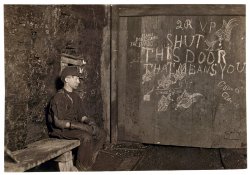
- Plane Jane: 1942
- ... View full size. 4x5 Kodachrome transparency by Alfred Palmer for the Office of War Information.
Looks like... a Flash Gordon ... digging those yellow overalls!
(The Gallery, Alfred Palmer, Aviation, WW2) ... Posted by Dave - 08/03/2012 - 3:21pm -
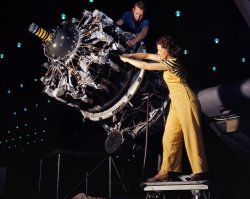
- The Girl in the Bubble: 1942
- ... View full size. 4x5 Kodachrome transparency by Alfred Palmer.
Day off? I wonder about the posed nature of this photo. True, ... a quick "hey you! Lemme grab a snap!". I just wonder how Palmer went about choosing his subjects.
[The large-format OWI ... Posted by Dave - 07/17/2012 - 10:04pm -
![The Girl in the Bubble: 1942 Bombardier nose section of a B-17F Navy bomber at the Douglas Aircraft plant in Long Beach, Calif. October 1942. The B-17F "Flying Fortress" is a later model of the B-17. View full size. 4x5 Kodachrome transparency by Alfred Palmer.
Day off?I wonder about the posed nature of this photo. True, women of the past rarely went out of the house unless they were well-coiffed, but wearing of jewelry in the factory was VERY discouraged. A dainty gold watch like hers could easily get caught in a machine or tool and cause injury (possibly what happened to her bandaged finger?).
No doubt this was a posed affair. Knowing the lighting requirements of Kodachrome, there's no way this was a quick "hey you! Lemme grab a snap!". I just wonder how Palmer went about choosing his subjects.
[The large-format OWI Kodachromes taken indoors at assembly plants do not, as a general rule, purport to be candid documentary photography; most were carefully composed and lighted, and taken for a specific purpose. As we have pointed out before, that purpose was often to serve as studies for the artwork used in posters for recruitment, bond drives, safety campaigns, etc. Example below. As far as "jewelry" goes, there's nothing especially remarkable about a 1940s assembly worker wearing a wristwatch. - Dave]
(The Gallery, Kodachromes, Alfred Palmer, Aviation, WW2)](https://www.shorpy.com/files/images/1a35360u_0.thumbnail.jpg)
- Wingwomen: 1942
- ... View full size. 4x5 Kodachrome transparency by Alfred Palmer.
They remind me of They remind me of Laverne and Shirley
... on the protective masks. Did photographer Alfred Palmer employ a polarizing filter to screen out reflections, or were they ... Posted by Dave - 08/10/2012 - 3:46pm -
![Wingwomen: 1942 October 1942. North American Aviation workers assembling wing component for a P-51 fighter. View full size. 4x5 Kodachrome transparency by Alfred Palmer.
They remind me ofThey remind me of Laverne and Shirley
[Wonder if I have any Kodachromes of the Blatz bottling plant ... - Dave]
women at warSeeing this picture reminded me of how proud I am of my mother. She worked at the Watervliet Arsenal (NY) during the war. Thanks for the memory.
Reese Witherspoon's MomI guess that's what I saw. She's cute
Made my ex jealousI have this as my desktop right now.
My ex-wife came over to pick up our son and almost the first thing out of her mouth when she came in the door was 'Who are THEY?'
I think it was the first time she didn't ask 'where do you find this crap?' I guess jealousy is an improvement.
[We here at Shorpy do what we can. Thanks for sharing! - Dave]
ArsenalI lived for a while on the other side of the fence from the Arsenal. It humbled me to think of all the amazing things that went on inside. I'm more so touched now to think of your mother.
Excellent attention to detailComposition and lighting show great care. Note how the lighting makes the subjects stand out from a potentially cluttered background.
Despite bright lighting, the facial features are not obscured by reflections on the protective masks. Did photographer Alfred Palmer employ a polarizing filter to screen out reflections, or were they removed in post-processing with Photoshop? Maybe both.
As with many images in this series, the women appear to be dressed and groomed for the photo op--a natural reaction.
(The Gallery, Kodachromes, Alfred Palmer, Aviation, WW2)](https://www.shorpy.com/files/images/1a35298u.thumbnail.jpg)
- Mouat Mine, Montana: 1942
- ... Stillwater County." 4x5 Kodachrome transparency by Alfred Palmer for the Office of War Information. Library of Congress. View full ... I can see. - Dave]
(The Gallery, Kodachromes, Alfred Palmer, Mining) ... Posted by Dave - 08/05/2012 - 6:38pm -
![Mouat Mine, Montana: 1942 August 1942. Stillwater County, Montana. "Development at the site of the mill for the Mouat Chromite mine. Mouat was recently constructed at the foot of one of the higher peaks in Stillwater County." 4x5 Kodachrome transparency by Alfred Palmer for the Office of War Information. Library of Congress. View full size.
Still there, still functioningNote text and picture at lower left, here:
http://www.stillwaterpalladium.com/stillwater2.html
Mouat Mine TodayIt looks like the buildings gave way to a holding pond over the years.
[Thanks thxdave for these great photos. Click to enlarge. - Dave]
Direct link?Dave, do you know if there's a way to create a direct link to the Google Earth "view" that you create on your own screen (elevation, angle, etc.) so people could go directly to the image?
[Hmm. Not that I can see. - Dave]
(The Gallery, Kodachromes, Alfred Palmer, Mining)](https://www.shorpy.com/files/images/1a35031u.thumbnail.jpg)
- Life in Wartime: 1942
- ... Woolslayer." Medium format negative negative by Alfred Palmer for the OWI. View full size.
French Vineyard? I never thought ... more here on Shorpy. - Dave]
(The Gallery, Alfred Palmer, Pittsburgh, WW2) ... Posted by Dave - 09/11/2011 - 11:34am -
![Life in Wartime: 1942 Pittsburgh, August 1942. "The comforts of home looked pretty good to Navy Radioman John Marshall Evans and Sergeant French L. Vineyard, who spent Sunday with the family of their poster colleague George Woolslayer." Medium format negative negative by Alfred Palmer for the OWI. View full size.
French Vineyard?I never thought I'd see a name to top Olive Groves (heard below), but that might just be it.
My GrandparentsGoogled my last name and was absolutely delighted to see my father's parents. I never knew this photo existed. For reference sake their names were Ethel Householder Woolslayer and George Anthony Woolslayer Sr.
[There are 48 more Woolslayer photos in the Library of Congress archive. And a couple more here on Shorpy. - Dave]
(The Gallery, Alfred Palmer, Pittsburgh, WW2)](https://www.shorpy.com/files/images/8e11122u_1.thumbnail.jpg)
- Five Sisters: 1850
- ... Juliaette Alcesta Clark, b. 1820; Laura Miles Clark Palmer, b. 1822.) View full size.
String-Things They're ripcords for ... Posted by Dave - 05/01/2008 - 7:29pm -
![Five Sisters: 1850 The Clark sisters circa 1850. Half-plate daguerreotype. Note on stationery of the Arts Club of Washington, in handwriting of Frances Benjamin Johnston, identifies sitters (l-r): "Aunt Harriet Allen, Aunt Ladonia Hoy, Grandma Joanette C-B, Aunt Julia Millard, Aunt Laura." (Harriet Elizabeth Clark Allen, 1818-1863; Ladonia Charlotte Clark Hoy, b. 1827; Joanette Clark Benjamin, c. 1814-1880; Juliaette Alcesta Clark, b. 1820; Laura Miles Clark Palmer, b. 1822.) View full size.
String-ThingsThey're ripcords for those corsets. Stand back!
InterestingYou can definitely see the family resemblance.
AmazingI wish I could write up the thoughtful comment that this photo deserves, but right now all I can muster up is: "wow". Because... wow!
LanyardsThey look like sterling silver needle cases. My great-great-grandmother had one, with the lanyard.
Needle CasesI agree, probably needle cases. I'm also guessing this is a rather well-to-do family, judging by the amazing garments and jewelry.
No smilesThey sure don't look happy- but people never do in old photos.
Makes me wonder if they were always frowning back then.
What are those things?Three of the sisters (center and to the right) have some kind of string or wire loop around their necks or attached to their dresses. That loop holds a small metal cylinder or ??? Any ideas?
Four sisters and one mother?Four are called aunts in the caption, but the one in the middle is "grandma" and probably mother to the other four. She does look older than the rest.
[You might want to do the math on those birth dates. Joanette is the grandmother of Frances (Fanny) Johnston, who wrote the caption. The others are Fanny's great-aunts. They are all sisters. - Dave]
Lanyards IIOr it could be a vial of smelling salts.
Where from?Any idea where this family is from? The stationery is from Washington -- are they as well? I was just trying to figure out what their fortunes might have been during the Civil War. Speculation, of course, but I'm a fan of that, as many others here seem to be as well.
[Frances Benjamin Johnston (1864-1952, below, who captioned this photo) was a well-known photographer with a studio in Washington. The 1880 census shows a Ladonia Hoy (born c. 1828) living in Baltimore. There is a portrait of Joanette in the LOC archive that was taken in New York. - Dave]
ThankfulOne of the many things that makes me thankful that I live in this day and age is that corsets are strictly optional! I wouldn't be smiling, either, if I had to spend my days bound up in one of those things. Those dresses don't look as though they were made for comfort, either. Grandma Joanette looks like she's wearing a set of quarterback's shoulder pads! To each her own.
Go Grandma JoanetteThanks Dave. Northerners then. And that's quite the picture of Grandma Joanette. Interesting contrast with her demeanor in the sister pic. When was this second one taken? (Sorry for all the questions--just too interesting, I guess!)
ImmortalizedThis photo is one of the portraits that most fascinate me. The pose so arranged, the textures of the dress (gorgeous!) The facial expressions of these women (now, dead), the gradations of gray, the wear suffered by the image and, of course, the desire to immortalize, explicit at each of the looks.
(The Gallery, Portraits)](https://www.shorpy.com/files/images/3d02003u.thumbnail.jpg)
- 1,200 Horses: 1942
- ... View full size. 4x5 Kodachrome transparency by Alfred Palmer for the Office of War Information.
blue sky Yep. Those of us old ... was once blue...
(The Gallery, Kodachromes, Alfred Palmer, Aviation, WW2) ... Posted by Dave - 08/30/2012 - 3:27pm -
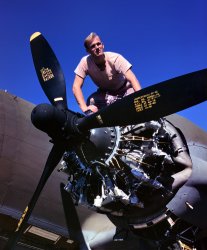
- Aim High: 1942
- ... four machine guns." 4x5 Kodachrome transparency by Alfred Palmer, OWI. View full size.
Rainbow Notion Thanks to Shorpy and the ... the time (Stuart).
(The Gallery, Kodachromes, Alfred Palmer, WW2) ... Posted by Dave - 08/13/2012 - 5:03pm -
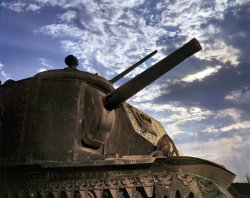
- Annette, Aluminum and You: 1942
- ... View full size. 4x5 Kodachrome transparency by Alfred Palmer for the Office of War Information.
Hurry Up! To me, that face ... you down from there.
(The Gallery, Kodachromes, Alfred Palmer, WW2) ... Posted by Dave - 07/17/2012 - 10:12pm -
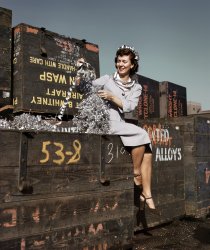
- Mustang by the Tail: 1942
- ... View full size. 4x5 Kodachrome transparency by Alfred Palmer.
I didn't suppose that color I didn't suppose that color ... - Dave]
(The Gallery, Kodachromes, Alfred Palmer, Aviation, WW2) ... Posted by Dave - 07/21/2012 - 10:34pm -
![Mustang by the Tail: 1942 October 1942. A painter cleans the tail section of a P-51 Mustang fighter prior to spraying with olive-drab camouflage. North American Aviation plant, Inglewood, California. View full size. 4x5 Kodachrome transparency by Alfred Palmer.
I didn't suppose that colorI didn't suppose that color photography looked that good these days
It must be a P-51B......judging by the incline on the spine.
Fate of the B-25sThe B-25 in the left background, tail #113178 (or 41-13178) crashed and burned at March Field in Southern California on June 30, 1943. The one on the right, #113180 (or 41-13180), was part of the 340th bomb group, 57th Bombardment Wing, Twelfth Air Force operating in Italy when it was shot down by antiaircraft fire on April 28, 1944. Three crew members, including the pilot were killed; the other four made it back to the base.
This is not THE photoThis is not THE photo taken at 1942, it's probably a reprint of the original negative.
[This is the original transparency. It is not a print. And Kodachromes don't have negatives. - Dave]
(The Gallery, Kodachromes, Alfred Palmer, Aviation, WW2)](https://www.shorpy.com/files/images/1a35303u.thumbnail.jpg)
- Victory Corps: 1942
- ... basement." Large format acetate negative by Alfred Palmer for the Office of War Information. View full size.
Re: Very ... sacrifice was not in vain.
(The Gallery, Alfred Palmer, Los Angeles, WW2) ... Posted by Dave - 02/25/2013 - 2:09pm -
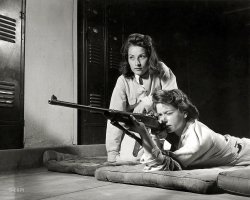
- Army Smartness: 1941
- ... up to Army standards of smartness." 4x5 negative by Alfred Palmer for the Office for Emergency Management. View full size.
... the odometer has no miles on it.
(The Gallery, Alfred Palmer, Cars, Trucks, Buses, Cleveland, WW2) ... Posted by Dave - 11/06/2014 - 3:50pm -
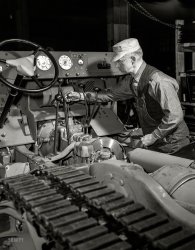
- Akron: 1941
- ... View full size. 4x5 Kodachrome transparency by Alfred Palmer.
Blimp Bay We still have one of these at Moffett Field in San ... drive by it when we are in Akron.
(The Gallery, Alfred Palmer, Aviation, Cars, Trucks, Buses, WW2) ... Posted by Dave - 08/03/2012 - 3:02pm -
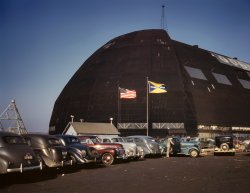
- Head Spotters: 1942
- ... Aluminum Industries Inc." 4x5 nitrate negative by Alfred Palmer for the Office of War Information. View full size.
Offstage ... get an accurate hardness reading.
(The Gallery, Alfred Palmer, Cincinnati Photos, Factories, WW2) ... Posted by Dave - 07/29/2012 - 2:40pm -
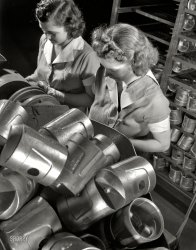
- Innerwing Inspectors: 1942
- ... View full size. 4x5 Kodachrome transparency by Alfred Palmer.
Love the style I wonder if they dressed that nice all the time ... herself look good.
(The Gallery, Kodachromes, Alfred Palmer, Aviation, WW2) ... Posted by Dave - 07/22/2012 - 12:46pm -
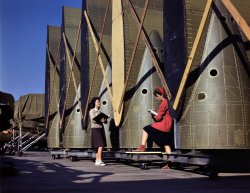
- Levers of Power: 1942
- ... Douglas Dam. 4x5 Kodachrome transparency by Alfred Palmer for the OWI. View full size.
Overwhelmed! The amount of ... a different breed!
(The Gallery, Kodachromes, Alfred Palmer, Industry & Public Works) ... Posted by Dave - 08/01/2012 - 1:34pm -
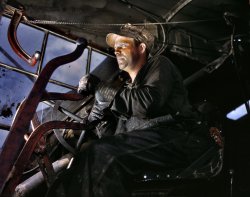
- Big Pete: 1942
- ... View full size. 4x5 Kodachrome transparency by Alfred Palmer.
Wow! Imagine the amount of information contained in this image ... about him? - Dave]
(The Gallery, Kodachromes, Alfred Palmer, WW2) ... Posted by Dave - 08/05/2012 - 10:53am -
![Big Pete: 1942 June 1942. "Big Pete" Ramagos, a rigger at work on the TVA's Douglas Dam in Tennessee. View full size. 4x5 Kodachrome transparency by Alfred Palmer.
Wow!Imagine the amount of information contained in this image compared to DSLR.
How?!I can't stop looking at this. I am terrified and in awe.
Hard Working FellaThis is the face of the men who built this country. Their industry is what made our economy flourish. It is production and not consumerism that makes a nation great. My hat is off to Big Pete and everyone like him that worked, and worked hard; for themselves, their families, and their country.
What's the Story Behind the Picture?I would really love to know more about Big Pete and what happened to him beyond the taking of this photo. The most amazing thing about Kodachrome is how well it makes yesteryear seem like yesterday, especially the medium and large format varieties. But the saddest thing is that the people who look so alive in them have often long since passed away. You can almost sense how much Big Pete is concentrating here, and how tiring the work must have been. I too am in awe of this picture. If anyone can shed any light on Pete I'd be very grateful.
This is my Great-GrandfatherI am so proud that this is a picture of my great-grandfather!
[What can you tell us about him? - Dave]
(The Gallery, Kodachromes, Alfred Palmer, WW2)](https://www.shorpy.com/files/images/1a35243u1.thumbnail.jpg)
- Dialog of Giants: 1942
- ... cranes at Douglas Dam." Kodachrome transparency by Alfred Palmer. View full size.
WOW Terrific photo, imagine what it took ... of them out there.
(The Gallery, Kodachromes, Alfred Palmer, Industry & Public Works) ... Posted by Dave - 06/30/2017 - 11:41am -
